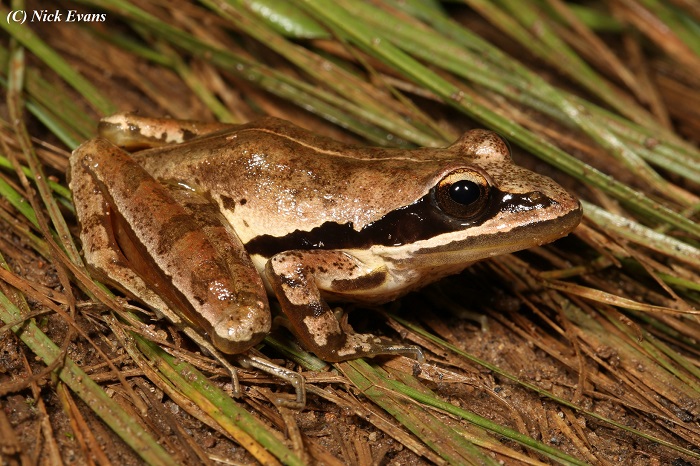View the above photo record (by Nick Evans) in FrogMAP here.
Find the Plain Stream Frog in the FBIS database (Freshwater Biodiversity Information System) here.
Family Pyxicephalidae
PLAIN STREAM FROG – Strongylopus wageri
Wager, 1961
Identification
S. wageri reaches 50 mm in body length. The dorsal colouration varies from uniform light brown or yellow-green to brick red, and is slightly paler on the snout. A distinct, dark band passes from the nostril through the eye to the shoulder and then continues along the flank. Faint barring on the legs and a narrow, pale vertebral stripe may be present (Wager 1965; Lambiris 1989a).
S. wageri may be distinguished from S. grayii, which sometimes has a similar dorsal colour pattern, by the extent of the webbing on the longest toe: in S. wageri no more than three phalanges are free of webbing, whereas in S. grayii, four or occasionally three phalanges are free of webbing (Poynton 1964; Passmore and Carruthers 1995).
The advertisement call is a short cackle c.500 ms in duration, repeated at irregular intervals. A call consists of a variable number of short notes, each about 50 ms in duration (Passmore and Carruthers 1995; Channing 2001).
Wager (1986) noted that tadpoles from Weza, Giant’s Castle and Mont-aux-Sources were identical, but Lambiris (1989a) found that adults from both Giant’s Castle Game Reserve and Entumeni Nature Reserve differ from the type series (Weza) with regard to webbing and colour pattern and suggested that they may represent an undescribed sibling species. The taxonomic status of the various isolated populations that do not form part of the main KwaZulu-Natal Drakensberg population, should also be examined as they may be in the process of speciation.
Habitat
At lower altitudes, S. wageri inhabits mistbelt forest, while at high altitudes up to 2000 m, it occurs in montane grassland. Adults may be found amongst vegetation or stones on the banks of clear streams and pools. Breeding takes place in clear, cold, fast-flowing streams and their pools.
Behaviour
Adults are active in the late afternoon and at night. When disturbed they jump into the water and remain motionless in the mud at the bottom, apparently relying on camouflage to avoid detection.
S. wageri breeds January–May, but mainly in autumn when water levels have stabilized (Channing 1979). Males call from concealed or partly concealed positions along the edges of streams or pools and sometimes under water (Lambiris 1989a).
In the laboratory, spawning was recorded at about 03:00. Clutches of 12–250 eggs are firmly attached to twigs or blades of grass dangling or submerged in the water, or to submerged rocks. The eggs measure 2.8 mm in diameter and are enclosed in a stiff, jelly-like capsule with a diameter of 5 mm, that swells to 7 mm after a few days. Eggs hatch after 8–9 days (Wager 1986; Channing 1979).
The tadpoles lie in the algae and mud at the bottom of the pools, moving slowly, but darting around rapidly if disturbed. They are often found in sunny positions in shallow water (Channing 1998). Tadpoles grow slowly in the cold of winter, and metamorphosis is completed after 5–9 months.
Adult S. wageri prey on terrestrial arthropods and gastropods (Channing 1979), as well as a variety of aquatic and semi-aquatic insects (Lambiris 1988e). In turn, they are probably eaten by a variety of vertebrates such as birds, snakes, otters and other frogs. Channing (1979) observed a crab climbing onto vegetation to devour the eggs of this species.
Status and Conservation
Status
S. wageri is placed in the category Near Threatened (Harrison et al. 2001; this publication) because of its small extent of occurrence and area of occupancy, fragmented distribution, and an existing and projected decline in the extent and quality of its habitat over a large part of its range. The species was not placed in a threatened category because it is relatively well protected in the reserves along the KwaZulu-Natal Drakensberg. It should be noted that S. wageri is heavily dependent on the continued protection of its habitat in these areas.
S. wageri is recorded from several conservation areas in KwaZulu-Natal, namely Ukahlamba Drakensberg Mountain Park, as well as Entumeni Nature Reserve, Ntsikeni Nature Reserve, Qudeni State Forest, Ngele Forest Nature Reserve and Ngome Forest Reserve.
Threats
In the past, S. wageri was probably more widespread on the Drakensberg escarpment in Mpumalanga, than at present. Much upland habitat in these areas has been destroyed by intensive afforestation with alien trees, and this is likely to have affected local populations of S. wageri. Channing (1979) noted that the destruction of indigenous forests has probably also resulted in loss of habitat to this species in KwaZulu-Natal.
Habitat loss to S. wageri is estimated to be >20% over the past 50 years, with a similar rate of decline in population numbers due to afforestation, chemical pollution associated with sylviculture, alien-plant invasions and the introduction of trout into streams (Harrison et al. 2001).
Recommended conservation actions
Extensive distribution surveys and monitoring of known populations are recommended. Habitat management, including the identification of limiting factors, is needed for effective conservation of this species (Harrison et al. 2001). It is especially important to determine whether S. wageri is able to survive in streams that run through plantations.
Distribution
S. wageri is endemic to South Africa. It has not been recorded at or near the summit of the Drakensberg in Lesotho (Bates and Haacke 2003). Distribution records are sparse and widely scattered. From the type locality on the Ngele Mountains near Weza Forest (3029DA) in KwaZulu-Natal, the species ranges northward along the escarpment and foothills of the Drakensberg mountain range. Isolated populations exist further to the east in KwaZulu-Natal, at Qudeni Forest (2830DB), Entumeni Nature Reserve (2831CD) and Ngome Forest Reserve (2731CD), and along the southern boundary of Mpumalanga Province.
Acocks (1975) suggested that in the recent past (A.D. 1400) KwaZulu-Natal was covered by forest and scrubforest, with grassveld on the summit of the Drakensberg. If so, this may explain the present disjunct distribution of this species in patches of forest that were once connected (Channing 1979).
Further Resources
Virtual Museum (FrogMAP > Search VM > By Scientific or Common Name)
More common names: Wager se langtoonpadda (Afrikaans)
Recommended citation format for this species text:
Bates MF, Tippett RM. Plain Stream Frog Strongylopus wageri. BDI, Cape Town.
Available online at http://thebdi.org/2021/12/15/plain-stream-frog-strongylopus-wageri/
Recommended citation format:
This species text has been updated and expanded from the text in the
2004 frog atlas. The reference to the text and the book are as follows:
Bates MF 2004 Strongylopus wageri Plain Stream Frog. In Minter LR
et al 2004.
Minter LR, Burger M, Harrison JA, Braack HH, Bishop PJ, Kloepfer D (eds)
2004. Atlas and Red Data Book of the Frogs of South Africa, Lesotho and
Swaziland. Smithsonian Institution, Washington, and Avian Demography
Unit, Cape Town.

